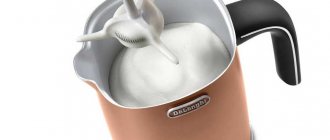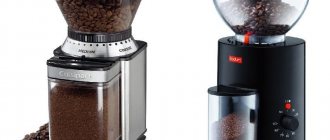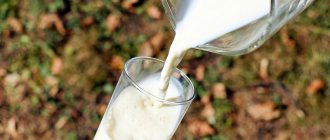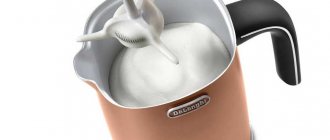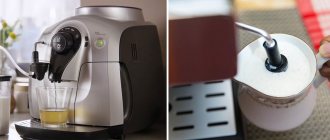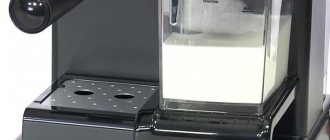For coffee lovers, it is important and fundamental to comply with all the conditions for preparing any coffee drink. Often there are difficulties when frothing milk. A pitcher can help in such a situation. What is it and what is it used for?
What is it like?
The pitcher is used to froth milk using steam. The resulting airy foam is added to the finished coffee drink. This jug is a must have for espresso machine owners. Coffee machines have a special attachment called a cappuccino maker. With its help, milk foam is whipped with steam in this particular jug.
Owners of an automatic or semi-automatic cappuccino maker will not need this device.
If you want to drink delicious coffee with a pleasant airy foam in the morning, then you should buy a pitcher. But it should be borne in mind that whipping milk foam on your own is not so easy, so you need to be prepared for failures. According to statistics, 10% of users cannot do it. This requires time to master this skill.
Another feature of the pitcher is its heat conductivity, which determines the taste of the brewed coffee. The main thing is not to bring the milk to a boil, but to heat it to the desired temperature.
It is permissible to heat up to 60-70oC. If the temperature does not reach 70 degrees, then the milk will acquire a naturally sweetened taste. If you overheat the milk, it will give off a bitter aftertaste, which is no longer suitable for foam.
What is a pitcher
A pitcher is a container designed for frothing milk for cappuccino. It is also sometimes called jag. Thanks to the pitcher, it is possible to obtain fluffy milk foam. Milk is poured into this bowl, which is then frothed by supplying steam from the coffee maker tube.
Such a vessel is necessary for preparing cappuccino and lattes for owners of coffee machine models equipped with a cappuccino maker.
If the unit does not have such a part, the jug is not capable of producing foam. In this case, it is allowed to use the pitcher as a milk jug. Fresh milk is simply poured into it and served immediately.
How to choose the right pitcher
Product material
Attention should be paid to the material from which the container is made. Pitchers are mainly made from stainless steel. It is also considered the best material for this type of cookware.
What is the advantage
In the store you can find pitchers made of metal or other various materials. The metal version is also good to use and can last a long time. But dishes made of ceramics, glass or plastic are considered less reliable.
Stainless steel also conducts heat well, which has a positive effect on the resulting foam, since during its production it is important to maintain temperature control.
External factors influence a metal pitcher much less than any other pitcher, so there is less worry about its condition.
If you plan to purchase a pitcher only for personal use, then you can consider models with Teflon coating, which is currently beginning to gain popularity. This material is easier to wash because milk practically does not settle on it. But due to the fact that Teflon wears off quite quickly, its service life is significantly reduced.
Pen
In most cases, pitchers have a handle that is shaped to be comfortable to hold while frothing milk. However, do not be surprised if it is completely absent. Currently, they produce pitchers with thermally insulating linings that allow you to hold the container in any convenient position.
Volume
The volume of the container ranges from 100 milliliters to 2 liters. The most popular are: 350 ml, 500-600 milliliters and 1 liter.
What pitcher do you use?
Metal
Ceramic
Why are there so many pitcher volume options?
It's quite simple. We must not forget that milk increases significantly in volume after whipping, so it is worth taking this into account when purchasing a pitcher of a certain size.
First, it is determined how much milk is needed for preparation, i.e. How many servings of coffee are you planning to prepare at one time? To make one cappuccino, there is simply no need for a lot of foam. But beginners who have had little practice in making foam before need to know a few subtleties.
We must remember that any pitcher is filled halfway with milk. If there is very little of it, then difficulties may arise with preparation due to the fact that it is easier to overheat it, which will render the resulting foam unusable. But many people like to use milk “with reserve”; naturally, this will require a large container.
And with a big pitcher there can be problems. At a minimum, whipping a small amount of milk in a large container is quite inconvenient, because... the steam tap may simply not reach the liquid level.
After purchasing a coffee machine or coffee maker, the next step is usually choosing accessories. For automatic coffee machines, this issue is not as acute as for carob coffee makers, but some things will be useful for grain machines.
For example, if you bought a coffee machine with a manual cappuccino maker and want to prepare milk and coffee drinks, a milk frother may make your task easier.
A pitcher (also known as a jug) is a vessel, a milk jug, in which the barista whips the milk before pouring it into cups. Used in the preparation of cappuccino, latte and other milk-coffee drinks
Let me clarify right away that for coffee machines with an automatic or semi-automatic cappuccino maker, as well as in the case of using a separate milk frother, the pitcher is irrelevant.
The pitcher is useful specifically for manually steaming milk. The steam frothing process itself is not so simple, and according to statistics, approximately 10% of users are unable to cope with the manual cappuccino maker of their coffee maker or coffee machine. With experience and skill, on the contrary, you can froth milk with a steam nozzle even better than with an automatic cappuccino maker.
There are a few things that will make using a steam tap easier:
- Knowledge of whipping techniques
- Proper milk
- Eligible Milk Pitcher
What is a milk pitcher?
I repeat, a pitcher is just a container, an analogue of a milk jug, except that it has a slightly special shape. In principle, the pitcher can be made of both plastic and ceramic. The standard for beginners, which I advise you to focus on, is a metal thin-walled pitcher. Painted metal pitchers with a non-stick coating are available on sale. In principle, to suit the interior, the design of the coffee maker, they can be safely used; this does not affect the whipping process, but I personally prefer without any coating.
The metal was chosen as the standard for a reason. When frothing milk, it is extremely important to bring and complete the process at a certain temperature of about 65-68°C. 60-70°C is acceptable. It is within these limits that milk begins to naturally sweeten without added sugar. If milk is overheated above 70°C, then in addition to the absence of a harmonious sweet taste (it disappears after 70°C), you will get a boiling taste, bitterness (they appear after 75°C). Up to 60 degrees, milk may simply be too cold for you, although in principle no one forbids adding 60-degree milk to the drink.
So, during the whipping process, you hold the pitcher by the bottom or the wall with one hand so that you can feel the temperature of the milk with your hand. You have to stop when your hand can no longer bear it. The second sign of a good pitcher is form. Usually it is a smooth cone slightly narrowed at the top with a clearly defined nose. Using this spout not only makes it easier (and easier to draw latte art) to pour milk into coffee, many baristas use it as a stop for the steam nozzle - they place the nozzle at an angle (and it is really better to hold it at an angle to the surface of the milk) directly into this spout , additionally fixing the pitcher, which allows you to be distracted by something else.
What size are coffee machine pitchers? How to choose the size?
Typical options: 350 ml, 500-600 ml, 1 liter. But in general, pitchers are very different, from 100 ml to 2 liters. It’s just that these volumes are the most popular.
When choosing a pitcher, it is important to understand how much milk you will typically froth at a time. Whisking in two batches is tedious if you drink large portions of dairy drinks. Frothing a small volume of milk in a large pitcher is particularly inconvenient. You need to assume that it is optimal to fill the pitcher from a third to a half.
That is, roughly, a 600 ml pitcher is for whipping from 200 to 300 ml of milk.
When milk is whipped, it increases in volume depending on the degree of whipping. You control the degree of whipping yourself depending on the drink you are preparing. Roughly, for a cappuccino the whipping is maximum, for a latte – seriously less. But for simplicity, you can focus on 2x magnification.
Thus, a 300-350 ml pitcher is just enough for about two servings of cappuccino. For 500-600 ml - for two latte macchiato.
Here you can find that a 100-150 milliliter pitcher is ideal for you, because you make one cappuccino for your wife and that’s it. Everything is correct, but here a subtle point emerges. The less milk, the more difficult it is to froth it properly without overheating. No, it is quite possible, but more difficult. Therefore, beginners often use a larger vessel and froth more milk than necessary, simply because it is easier for them. Personally, I don't see much point in buying a small pitcher in principle.
The opposite is also true. A pitcher that is too large is not always convenient when you need to froth a small amount of milk. If only because in this case you will have to insert the pannarello cappuccino maker deeply inside the pitcher, and this is not always possible due to the length of the cappuccino maker. For example, the popular line of Delonghi ECP31.21/33.21 carob coffee makers has a steam tap length of only 9.5 cm; there is no way to lower it lower - the pitcher rests on the metal steam supply tube. You simply won’t be able to reach the milk and you will always have to pour more than you need.
And for some coffee makers, a large pitcher is completely contraindicated for any volume of milk. Take, for example, another popular model of home carob coffee makers - Saeco Poemia. Due to the small height “under the pannarello”, a large jug simply will not fit there, or it will be very difficult to move and tilt it.
Finally, the height of the coffee maker and its cappuccino maker is important if you like to reheat the milk after frothing by lowering the steam valve to the bottom of the pitcher. So before purchasing, it is better to decide on the desired volume and take into account the dimensions of your specific coffee machine/coffee maker.
What about pitchers with a built-in thermometer?
Yes, such models exist. But it’s precisely that I personally have never encountered the built-in one in real life. They are rare. The second subtle point is that I have only seen it on sale from the Chinese (for example, on Aliexpress), and I have concerns about the accuracy of such a temperature sensor. In any case, with experience, you will not have any problems determining the temperature of milk with your hand.
If you are a beginner, then a good solution would be to choose a separate immersion thermometer (for example, a “brand” ILSA or a nameless analogue half the price on Ali). They are quite accurate (at least a couple of the ones I've tried) and can really help in the early stages of learning the foaming technique. Then, when you get used to it, you can simply not use it.
On the left is a pitcher with a built-in thermometer. On the right is a pitcher with an immersion thermometer mounted on the edge.
Where can I buy this milk pitcher?
In fact, the pitcher is not such a common thing that is sold on every corner. It’s generally extremely difficult to find them right away in an offline store near your home, except that METRO C&C definitely sells them (made in India). In theory, they should be in kitchenware stores, but I haven’t checked. Tip: Sales consultants usually don’t know what a pitcher is, so it’s easier to ask to find a “metal milk jug.”
In Russian online stores:
- Culinary boutique Boffo
- Online store for fresh coffee Tasty
- Online store of fresh coffee Bravos
- The all-knowing Yandex.Market will suggest a dozen more options
And as usual, the cheapest is from China from Aliexpress:
- Regular unpainted, classic - once
- Fashionable multi-colored - two
Branded from Europe:
- As part of the Barista Set from Cafelat. €100, delivery to Russia in ~7 days (free and duty free). In addition to the pitcher, the kit includes: a 58 mm tamper, a knock box and a barista mat.
Photos used in the text by Angie Chung under an Attribution-ShareAlike 2.0 Generic license
Additional options worth considering
Wall thickness
Professional baristas opt for pitchers with thick walls. They warm up slowly, allowing the milk to froth longer. In this case, the foam will turn out much more fluffy and soft.
Beginners give preference to pitchers with thin walls. They make it easier to control the heating temperature. Of course, their cost is lower, which also affects the choice.
Built-in thermometer
At the moment, pitchers have appeared with a built-in thermometer located at the bottom of the container. It helps to accurately determine the temperature, which allows you to achieve the perfect foam.
Form
It is important to pay attention to the shape of the dishes. A smooth cone-shaped shape, which slightly tapers upward, with a clearly defined nose, is considered convenient.
Color
If when choosing it is important that the dishes fit favorably into the interior, then you can take a closer look at the pitcher with Teflon coating, which stands out in matte black. If you look harder, you can find rare white and colored matte ones.
Criteria for choosing the right milk jug for coffee
When choosing, consider the volume of the product, material, and the presence of a handle.
Material of manufacture
Pitchers are made from a number of materials:
- Of stainless steel. The material is best suited for making milk jugs. The good thermal conductivity of the metal allows the barista to sense in a timely manner that the contents of the container have become hot and stop whipping. Steel does not react with food and does not impart an unpleasant taste or odor to the drink.
- Plastic. Pitchers made from this material are cheaper. The product, however, is easier to damage during operation. In addition, the material reacts with the contents of the container, causing the coffee to have an unpleasant aftertaste and spoil the aroma.
- Aluminum. Such jags are not very comfortable due to poor thermal conductivity. It will be difficult for baristas to keep track of when the milk has warmed up. Because of this, foam with a boiling taste and bitterness may get into the drink.
- Ceramics. Ceramic products are not very convenient due to their fragility. In addition, their thermal conductivity is worse than that of metal, which will make it difficult for beginners to work with. Some housewives, however, prefer ceramic pitchers because of their appearance.
Materials for making a pitcher.
Pen
For beginners, it is better to choose products with a handle that is comfortable to hold. Experienced baristas can purchase a milk jug that does not have this part at all.
The product has a comfortable handle.
Volume
The volume is selected depending on how many people the coffee will be brewed for. To whip up foam for one drink, a container with a capacity of 100 ml or more is suitable.
For two, it is better to choose a jug with a volume of 350 ml or more. If you drink latte or cappuccino in the office, or prepare it for a large family or company, it is recommended to purchase a milk jug that holds 1-2 liters of liquid.
Containers with different volumes.
Step-by-step instructions for whipping
To get a thick foam, follow the algorithm:
- Using the steam tap, remove condensation from the container, which can spoil the taste of the drink.
- Fill the pitcher halfway with milk. Immerse the steam tap into the liquid by 1-1.5 cm and use it to heat the contents of the container to +37°C. At this stage, the milk should not be overheated, since its taste will deteriorate and the foam may not be thick enough.
- Open the tap to start frothing. Bubbles should appear over the entire surface of the liquid.
- Keep an eye on the sounds as you go. There should be a uniform hissing sound. Gurgling or muffled sounds indicate that the faucet is immersed too deep. If the milk splashes out during the process, the immersion depth is insufficient.
- Then proceed to steaming. This phase lasts from 5 to 15 seconds. Stir the milk continuously in a circular motion as you go. This way the contents of the container will become homogeneous and evenly warm up to +70°C.
- When the process is complete, remove the faucet. Then lightly tap the sides of the pitcher to settle the bubbles. Shake the milk mass until it gets into the coffee.
Immediately after finishing work, wash the pitcher from any remaining milk.
Places of purchase and average cost in stores
You can buy a milk jug in a specialized boutique that sells tableware for coffee shops, bars, or coffee accessories. Products are also offered in the online stores Boffo, Tasty, and Yandex.Market. The cheapest pitchers can be found on AliExpress.
The cost depends on the volume and material. A 100 ml ceramic pitcher can be bought for 400 rubles. A metal product is more expensive: the cost starts from 700 rubles.
Milk jugs holding 1 liter or more sell for 2,400 rubles. The price increases additionally for painted products, jugs with Teflon coating or a thermometer.
Buy quality pitchers from specialized coffee shops.
